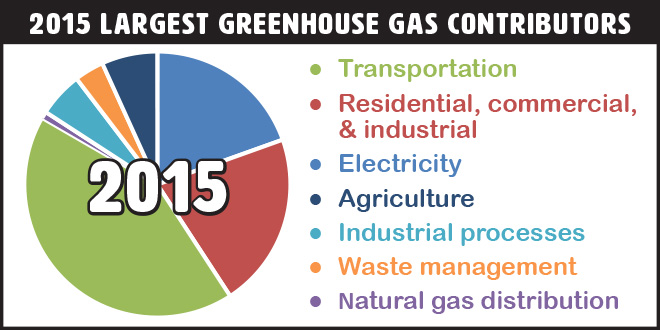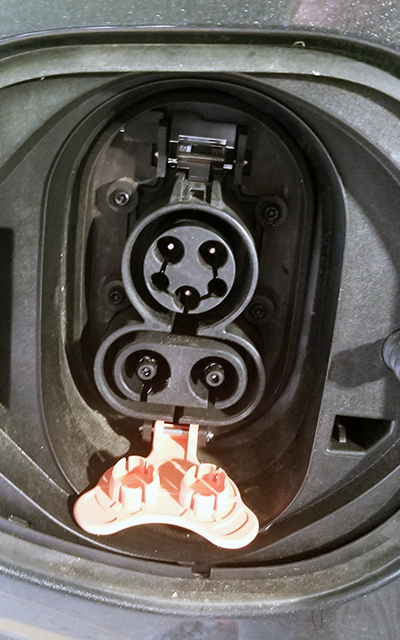Last month, Washington state reached our 2020 goal of having 50,000 zero-emission electric vehicles on the road. This figure includes plug-in hybrids, all-electric, and hydrogen fuel-cell vehicles.
Emissions from transportation contribute nearly half of Washington’s greenhouse gas pollution—the pollution that is causing climate change. That’s a huge deal to us at Ecology. It’s why we’re shifting more and more of our agency fleet to zero emission vehicles, and it’s why we’re investing much of Washington’s $140 million from the Volkswagen diesel cheating scandal into zero emission vehicles and infrastructure.
What is a ZEV?
ZEVs are any vehicle that releases zero, or nearly zero, emissions during operation. ZEVs continue their clean operation throughout their lifespan, unlike standard vehicles which typically produce more air pollution as they age.
There are two types of ZEVs:
- Battery electric vehicles (EVs / BEVs) run entirely on batteries and are recharged from the electrical grid.
- Hydrogen fuel cell vehicles (FCVs) run on electricity produced from a fuel cell using compressed hydrogen.
Although not zero emission vehicles, the following hybrids are worth mentioning for those who are concerned about finding convenient charging stations, or need longer driving ranges, while still reducing their carbon footprint:
-
Plug-in hybrid vehicles (PHEVs) combine a smaller conventional gasoline-powered engine with a battery that can be recharged from the electrical grid.
-
Hybrid electric vehicles (HEVs), are vehicles that you don’t plug-in. HEVs still provide the benefits of high fuel economy and low tailpipe emissions.
How much do ZEVs cost?
ZEVs come in all shapes and sizes, from compact cars to SUVs, and just like standard-engine vehicles, vary in price and amenities. Compact models are as low as $24,000, but most ZEVS now cost around $40,000 new, close to the same cost of a conventional vehicle.
Owners can expect to save around $6,400 in lower maintenance costs — even before tallying up the fuel savings. ZEVs don’t require oil changes, transmission fluid, spark plugs, or air filters. Brake pads usually last much longer in electric vehicles and can capture and reuse as much as one-fifth of the energy normally lost during braking through “regenerative braking.” This means, when you use your brake, you are helping charge your battery!
So… about those fuel savings. That’s where ZEVs really shine. Considering that Washington has very low electricity costs in the nation (80 percent of it generated from renewable resources, like hydro and wind) some ZEVs cost less than $1 to reach a full charge. Compare that to the cost of refueling a conventional car.
Are there tax breaks if I buy a ZEV?
Yes! The federal “Qualified Plug-In Vehicle Tax Credit” offers tax credits from $2,500 - $7,500 based on battery size, vehicle weight, and emission standards.
Additionally, here in Washington, the Legislature just re-upped a sales tax credit on qualified zero emission vehicles, that knocks up to $2,500 off.
You can get more information on these federal and state credits on the Office of Energy Efficiency & Renewable Energy website.
Is it easy to charge an electric vehicle?
A typical ZEV has a range between 60 and 240 miles. In 2018, Washington had 2,401 public charging stations, and has awarded grants to install 15 more along highway corridors. Ecology is working with state and local governments to add dozens more charging stations at offices, and there are a variety of other programs working to fill in that charging network in the months and years ahead.
To find a charging station on the west coast, visit the West Coast Green Highway map. For charging stations around the nation visit the Plug Share website that has over 300,000 charging locations mapped. There are three levels of charging:
-
Level 1 – This type of charging takes about 12-24 hours for a full charge and plugs into any standard 120 volt outlet using an adapter.
-
Level 2 – This type of charging takes about 4-5 hours to reach a full charge. It is a 240 volt circuit (similar to your dryer) and is the most common type found at public charging stations.
-
Level 3 – Level 3 chargers provide an 80 percent charge in just 20-30 minutes. Level 3 chargers may be harder to find.
Many charging stations are free, or accept credit cards, or a smartphone app to pay for charging. The unspoken “code” of charging gives priority to those whose battery is lowest, and courtesy requires moving your vehicle to a vacant parking spot once it is charged.
For the “techy” driver, there are a multitude of apps to help you find charging stations, show your current charge, notify you when your vehicle is fully charged, and allow you to set timers to start and stop charging.
What about the batteries?
Most electric vehicle batteries come with a standard 8 year warranty but can last years longer. Replacement batteries can cost anywhere from about $1,000 to $6,000. Batteries are expensive to replace, so do your homework before buying a used ZEV with higher miles.
Because ZEV batteries are large and built to last, their environmental footprint up front may appear larger than standard vehicles. However, over its life, an electric vehicle produces far lower emissions than a gas-powered car. A qualified technician is required to change and recycle the battery as the battery is housed in the center of the vehicle for even weight distribution. What are they like to drive?
ZEVs are so quiet that when you first start them, you may think the car isn’t running. Electric motors produce their maximum amount of torque immediately, which means ZEVs usually provide snappy acceleration. And, the big electric motors in ZEVs also work in reverse: Simply letting up on the accelerator while in “low mode” will slowly bring you to a stop, allowing you to use one-pedal driving.
Washington is leading the transformation
Washington state is already a leader in electric vehicles thanks, in part to state sales tax incentives. Governor Jay Inslee signed an executive order in 2019 requiring that 50 percent of all new state-owned and leased passenger vehicles to be electric by 2020.
To date Ecology has a number of electric vehicles in its state fleet. Currently, there are:
-
36 hybrid electric (Toyota Prius)
-
6 plug-in hybrid electric (2 Ford Fusion, 1 Chevrolet Volt & 1 Mitsubishi Outlander)
-
16 fully electric (Chevrolet Bolt)
Last week, Ecology employees participated in National Drive Electric Week. It was a great opportunity to learn the multitude of benefits and test drive a ZEV.
Electric vehicles are the right choice
An average gasoline-powered car produces about 4.6 metric tons of carbon dioxide emissions each year. A ZEV vehicles produces….zero. Hydrogen fuel cell vehicles emit only harmless water vapor.
In order for Washington to meet its greenhouse gas reduction goals we need to drastically reduce pollution from transportation, and we need to do it fast. Governor Jay Inslee has set a goal of having every vehicle in Washington run on electricity by 2050. Electric vehicles ensure cleaner, healthier air. Less pollutants means less exposure to toxic substances and better health for you, and the environment.
For more information, visit the following website:
Electric Cars 101: The answers to all your EV questions




